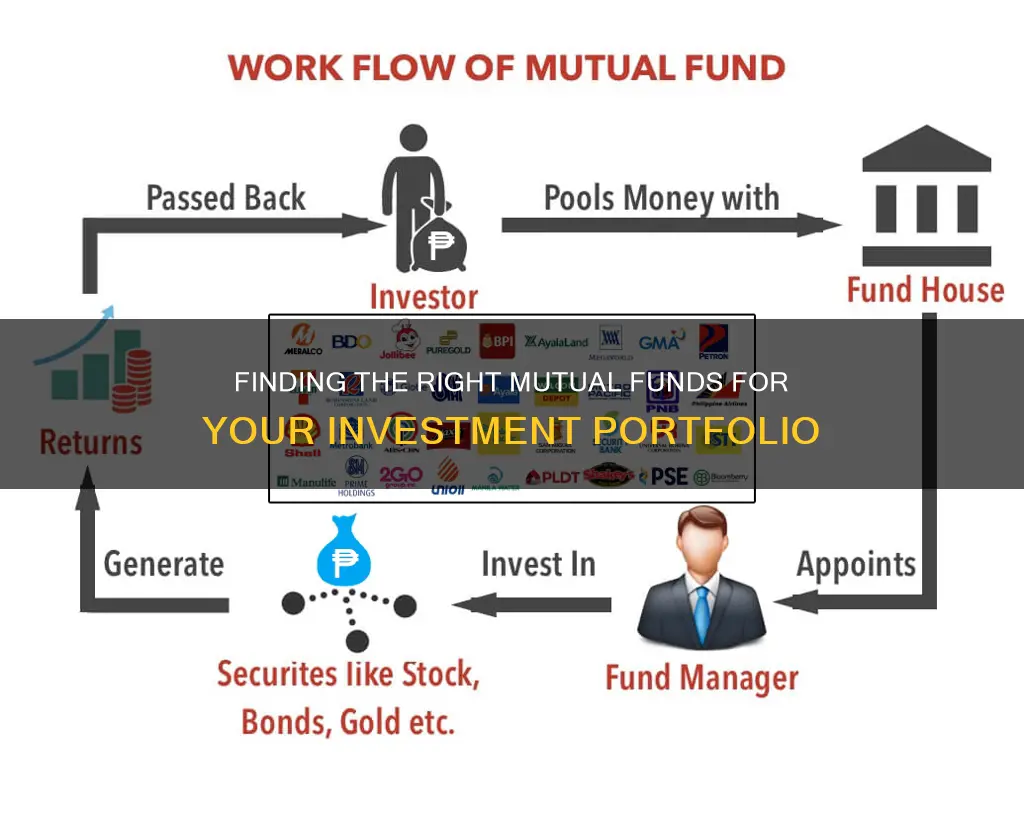
Mutual funds are a popular investment tool for those seeking to beat the market or simply access a wide range of investments. They are a type of investment vehicle that pools money from multiple investors to purchase a diversified portfolio of stocks, bonds, or other securities.
With thousands of mutual funds available, choosing the right one can be challenging. This guide will introduce you to the basics of mutual funds and provide steps on how to find the right mutual funds to invest in.
| Characteristics | Values |
|---|---|
| Investment type | Stocks, bonds, real estate, derivatives, securities, commodities, etc. |
| Management | Actively managed or passive |
| Risk | High, medium, low |
| Returns | High, medium, low |
| Fees | Expense ratios, sales charges, redemption fees, account fees, etc. |
| Accessibility | Brokerage account, direct from fund company, financial advisor |
| Suitability | Long-term, short-term, retirement, etc. |
| Tax implications | Taxable brokerage account, tax-deferred account, tax-advantaged retirement account |
What You'll Learn

Understand the different types of mutual funds
There are four main types of mutual funds: stock, money market, bond, and target-date funds. Each type has its own investment focus and strategy, and it's important to understand the differences before investing. Here's a closer look at each type:
- Stock Mutual Funds: These funds invest principally in equity or stocks. They are typically categorized by the size of the companies they invest in, such as large-cap, mid-cap, or small-cap funds. They can also be categorized by their investment approach, such as growth or value funds. Stock mutual funds have a higher potential for growth but also come with more potential volatility in value.
- Money Market Mutual Funds: These funds invest in high-quality, short-term debt from governments, banks, or corporations. They are considered low-risk investments and make up a significant portion of the mutual fund market.
- Bond Mutual Funds: Bond funds are a type of fixed-income mutual fund, where investors are paid a fixed amount back on their initial investment. They are considered safer than stocks but have less potential for growth.
- Target-Date Mutual Funds: These funds automatically adjust their asset allocation as the target date, usually retirement, approaches. They typically start with a higher allocation of stocks and gradually shift towards more conservative investments over time.
In addition to these main types, there are also index funds, which aim to replicate the performance of a specific market index, and specialty or alternative funds, which include hedge funds, managed futures, commodities, and real estate investment trusts. Socially responsible investing (SRI) funds are also becoming increasingly popular, as they focus on funding companies with strong environmental and social practices.
When choosing a mutual fund, it's important to consider your investment goals, risk tolerance, and the fees associated with the fund. Active funds, which aim to outperform the market, tend to have higher fees, while passive funds, which aim to replicate an index, are generally lower-cost.
High-Yield Bond Funds: When to Invest and Why
You may want to see also

Research fees and expenses
Fees and expenses are an important consideration when choosing a mutual fund to invest in. Mutual funds charge annual fees, expense ratios, or commissions, which reduce their overall returns. These fees cover the fund's operating expenses, including management fees, administrative costs, and marketing expenses. The most common fee is the expense ratio, which represents the percentage of the money you invest that will go towards covering the fund's costs rather than generating a return. The expense ratio is expressed as a percentage of the fund's average net assets and is deducted from the fund's returns. For example, a fund with a 1% expense ratio will cost you $10 for every $1000 invested. While a mutual fund with a lower expense ratio is generally preferable, it's also important to consider the fund's performance and whether it aligns with your investment goals.
Mutual funds may also charge sales fees or "loads" when you buy or sell shares. Front-end loads are charged when you purchase shares, while back-end loads are assessed if you sell your shares before a certain date. Some funds are marketed as "no-load funds", which don't have commission or sales charges. Redemption fees are another type of fee charged by some mutual funds when you sell your shares within a short period (usually 30 to 180 days of purchasing them). These fees are designed to discourage short-term trading and promote stability. Additionally, some funds or brokerage firms may charge extra account fees or maintenance fees, especially if your balance falls below a certain minimum.
It's important to carefully review the fund's prospectus and consider the impact of fees on your investment returns. Fees can compound over time and eat into your overall returns. By comparing fees and expenses across different mutual funds, you can make a more informed decision that aligns with your financial goals and risk tolerance. Remember that even small differences in fees can have a significant impact on your long-term investment returns.
Fund Setter: Minimum Investment Requirements and More
You may want to see also

Decide on active vs passive funds
When deciding on active vs passive funds, it's important to understand the differences between the two. Active investors are those who buy stocks or other investments regularly and tend to take a hands-on approach, often involving a portfolio manager. They search for and buy investments that are performing or that they believe will perform and sell those that are not meeting their standards. Passive investors, on the other hand, rarely buy individual investments and instead hold investments over a long period or purchase shares of mutual or exchange-traded funds. They tend to rely on fund managers to ensure the investments held in the funds are performing well and expect them to replace declining holdings.
There are several advantages to passive investing. Firstly, it tends to be more cost-effective due to ultra-low fees since there is no need to pay for stock picking. Passive funds simply follow an index and do not require extensive analysis. This also leads to greater transparency, as investors always know which assets are in an index fund. Additionally, the buy-and-hold strategy of passive investing results in tax efficiency, as it typically does not result in a large capital gains tax for the year.
However, proponents of active investing argue that passive strategies have limitations. Passive funds are restricted to a specific index or predetermined set of investments, offering little flexibility. As a result, investors may miss out on opportunities for higher returns. Passive funds also rely on fund managers to make decisions, which may not align with the investor's specific goals or preferences.
Active investing offers several benefits that passive investing does not. Active managers have the flexibility to buy those "diamond in the rough" stocks that may have been overlooked by passive investors. They can also employ various hedging techniques, such as short sales or put options, to manage risk. Additionally, active investing allows for tax management strategies tailored to individual investors, such as selling investments that are losing money to offset taxes on winning investments.
When deciding between active and passive funds, it's important to consider the fees, level of involvement, and potential returns. Passive investing tends to be more cost-effective and may provide better overall returns, especially for novice investors. On the other hand, active investing offers more flexibility and the potential for higher returns, but it also comes with higher fees and the risk of underperforming the market. Ultimately, the decision between active and passive funds depends on your investment goals, risk tolerance, and the time and resources you are willing to dedicate to managing your investments.
Business Fund Investments: Expansion Strategies and Opportunities
You may want to see also

Choose a brokerage account
Choosing a brokerage account is an important step in investing in mutual funds. Here are some things to consider when selecting a brokerage account:
Affordability
Mutual fund investors typically face two types of fees: transaction fees from the brokerage account and expense ratios and front- and back-end "sales loads" from the funds themselves. When choosing a brokerage account, look for one that offers a wide range of no-transaction-fee mutual funds to help keep costs down. Additionally, consider the expense ratios charged by the funds offered by the brokerage. Lower expense ratios mean more of your money is invested and compounding rather than being paid out in fees.
Fund Choices
The number of mutual funds offered by brokerages can vary significantly. Some brokerages may only offer a dozen or so funds, while others provide access to thousands of funds across various fund companies. If you want a broader selection of funds to choose from, look for a brokerage with a more extensive fund offering.
Research and Educational Tools
When investing in mutual funds, it's crucial to understand the funds' strategies, performance, fees, and other factors. Therefore, selecting a brokerage with robust research and educational tools can be beneficial. Look for a brokerage that provides fund screening and research tools, performance data, and detailed fund information to help you make informed investment decisions.
Ease of Use
The usability of a brokerage's website or app is an important consideration. Choose a brokerage with a user-friendly interface that you find intuitive and easy to navigate. This will make managing your investments more convenient and help you stay on top of your investment portfolio.
- Fidelity Investments: Offers a wide range of mutual funds, including four zero-fee funds, and extensive research tools.
- Charles Schwab: Provides a large selection of no-load, no-transaction-fee mutual funds and competitive pricing.
- E-Trade: Offers more than 6,000 no-load, no-transaction-fee mutual funds and comprehensive research and screening tools.
- Ally Invest: Provides access to over 17,000 mutual funds and charges no commission on no-load funds.
- The Vanguard Group: Known for its low-cost index funds, offering over 3,000 no-transaction-fee mutual funds.
- J.P. Morgan Self-Directed: Offers approximately 3,000 no-transaction-fee mutual funds and a customizable screener for mutual funds and ETFs.
- Interactive Brokers: Offers a vast selection of nearly 18,000 no-transaction-fee mutual funds, suitable for both regular investors and professionals.
Vanguard Funds: Best Bets for New Investors
You may want to see also

Calculate your investing budget
When deciding how much money to invest in mutual funds, it's important to calculate your investing budget. Here are some steps to help you determine your budget:
Step 1: Figure Out Your Income and Expenses
Start by calculating your after-tax income, which is the amount of money you take home after taxes and other deductions. This will give you a clear idea of how much money you have to work with. Then, make a list of your essential monthly expenses, such as rent or mortgage, utilities, groceries, transportation, and insurance. Don't forget to include any existing debt payments, such as student loans or credit card debt.
Step 2: Determine Your Financial Goals and Priorities
Think about your short-term and long-term financial goals. Are you saving for a down payment on a house, funding your retirement, or investing for your child's education? Prioritize your goals based on their importance and urgency. For example, building an emergency fund or saving for retirement might take precedence over other goals.
Step 3: Calculate Your Disposable Income
Subtract your essential expenses from your after-tax income to determine how much money you have left each month. This disposable income is what you can use for investing, as well as for any non-essential expenses or leisure activities.
Step 4: Allocate Your Funds Accordingly
Now, decide how much of your disposable income you want to allocate to investing in mutual funds. Keep in mind that investing in mutual funds typically requires a minimum initial investment, which can range from a few hundred dollars to $1,000 or more. You can also make regular contributions, either monthly or annually, to continue growing your investment.
Step 5: Consider the Risks and Returns
Investing in mutual funds carries a certain level of risk, and the potential returns can vary. When deciding how much to invest, consider your risk tolerance and the expected rate of return for the specific mutual funds you're interested in. Remember that historically, the stock market has averaged much higher returns over several decades, but past performance does not guarantee future results.
Step 6: Seek Professional Advice
If you're unsure about how much to invest or which mutual funds to choose, consider consulting a financial advisor. They can help you assess your financial situation, goals, and risk tolerance to create a personalized investment plan.
Remember, investing in mutual funds is a long-term commitment, and it's important to do your research and understand the risks and potential returns before making any decisions.
Vanguard Mutual Funds: Are They Worth the Investment?
You may want to see also
Frequently asked questions
You should first consider your savings goals and risk tolerance. Then, you should research different funds and their management teams, turnover rates, and historical performance. Finally, you should decide whether you want an index fund or an actively managed fund.
Mutual funds offer investors a secure and diversified portfolio of investments. They are affordable, professionally managed, and highly liquid.
All investments carry risk, and mutual funds are no exception. You may lose some or all of your investment. The value of the fund's portfolio may decline, and bond interest payments or stock dividends can fall as market conditions change.







